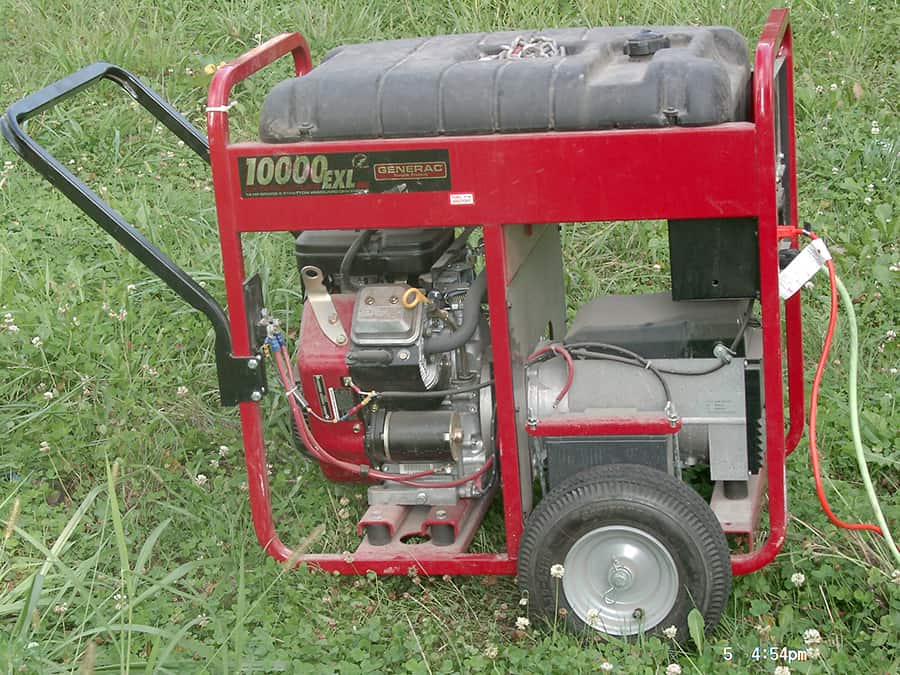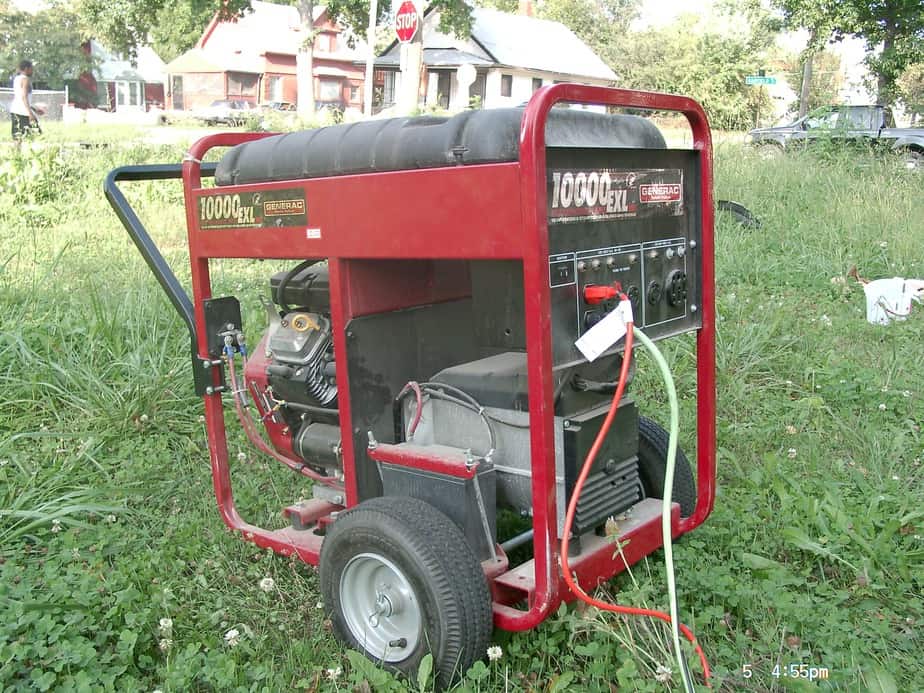Proper generator maintenance can be a lifesaver. This includes planning, knowing what to look out for, and ensuring proper storage.
The maintenance tips we’re about to dive into are ones I recommend to my industrial clients, so they’ll definitely apply to your at-home portable generator too. Just make sure your generator is off and cool before doing any work to avoid electric shocks, burns, or explosions.

Important Note: Every generator comes with an owner’s manual, so get familiar with yours since it’s unique for every model. Follow the recommended maintenance schedule and safety guidelines.
These 12 generator maintenance tips in this article aren’t meant to replace what’s in your manual. Instead, they’re here to fill in the gaps if your manual is missing something.
#1 Maintain superb airflow with a clean air filter
A poorly conditioned air filter is more likely to cause damage to your generator. If you’ve ever replaced your HVAC unit or car filter, you know how fast they can get filthy. Portable generator filters are no different.
So, swap them out if they look dirty. It’s worth it, considering how cheap they are and the future repair costs they’ll save you.
If you’re running your generator non-stop, take some extra safety precautions. I recommend checking your air filter’s condition every time your generator is in use. And for the sake of simplicity, just replace it every month to avoid future issues.

Important Note: If you decide to wash your air filter, be careful not to tear it. Gently wash it with soapy water and a clean, soft cloth. Then, let it air dry for 24 hours before putting it back into the generator.
#2 Engine cleaning and inspection

The engine is the heart of your generator, so keep it clean and in tip-top shape. But remember, don’t ever use a pressure washer – you can do more harm than good.
Instead, use a compressed air duster to remove dust. Then, grab a clean, soft rag with a degreaser to wipe away any dirt and grime.
As a bonus tip, stay alert while cleaning your generator and keep an eye out for any issues. You might just find a broken part while you’re exploring the engine’s nooks and crannies.
#3 Check the fuel strainer
Inspect the fuel strainer in the fuel tank monthly. If you find any clumped-up particles, give the strainer a good cleaning. And if it’s got any damage like holes, go ahead and replace it.
To clean your fuel strainer, backflush fuel or carburetor and choke cleaner through the nozzle. If that doesn’t do the trick, blow low-pressure air through the strainer nozzle. But don’t use any pressure greater than 10 psi.
A clogged fuel strainer can cause all sorts of headaches like:
- Engine starting difficulties
- Reduced fuel efficiency
- Sputtering engine
- Irregular high engine temperatures
#4 Check fuel lines
With lots of use, generator fuel lines can really take a beating. They can crack, tear, or get clogged up. As a result, gas might not make it to your generator’s fuel system, causing it to run inefficiently or not even start at all.
I recommend replacing any damaged fuel lines right away. Trust me, it’s not worth the hassle to fix them with adhesive, especially since they’re pretty cheap.
Just as important, replace your fuel filter when it’s damaged. And if your generator doesn’t have one, go ahead and add one. Fuel filters are great at screening out dirt and rust particles from the fuel.
#5 Replace engine oil
You change your car oil every X,000 miles like clockwork, right? Now, show your generator’s engine the same love!
I recommend checking and replacing your oil every 50 or so hours of runtime. Simply drain the old oil and fill it up with regular or synthetic oil. Synthetic oil performs better for generator cold starts and extreme heat operation. If you’re running your generator at full load non-stop, change your oil more frequently.
It’s a good idea to keep extra oil on hand, so you can replace it on schedule without any last-minute panic. Imagine worrying about finding oil in the dark when you’ve lost power to your home.

Important Note: Make it a habit to check your engine oil before starting. Running your generator with an empty oil tank can damage your engine.
#6 Check for leaks
It might seem obvious, but small leaks can often fly under the radar. So, keep an eye out for leaks, as they’re pretty common with generators.
Start by checking your fuel lines, where leaks tend to happen most often. Weather and age can cause cracks in fuel lines, and couplers can loosen up. Next, examine your carburetor bowl gaskets, as they can dry out and get damaged, compromising the seal and causing fuel to leak below the carburetor. Don’t forget to check the following:
- Fuel tanks: Over time, fuel tanks can become brittle, as welds on seams weaken, and corrosion and punctures set in. Extreme temperatures, overfilling, and acid and salt build-up are typically the culprits.
- Pipes: Pipes can become loose and experience the same wear and tear as fuel tanks.
- Shut-off valve: Valves can become loose and damaged from normal usage.
If you ever notice an oil leak in your generator, it’s super important to take care of it ASAP. Don’t even think about running your generator until you’ve dealt with the leak, as it could lead to some really serious safety hazards like explosions, fires, or even toxic fumes escaping.
#7 Check your battery
Not all generators come with batteries, but if yours has an electric start, it’s important to give it a quick check. If you haven’t used your generator in a while, make sure the battery is fully charged. And to keep it ready for any emergency situations, consider using a trickle charger.
If you’re a heavy generator user, it’s even more important to inspect your battery. Look for any signs of corrosion and make sure the cables aren’t loose at the terminals. It’s also a good idea to use a multimeter to test your battery’s voltage and perform a load test every month or so to keep tabs on its health.
#8 Check your spark plugs
If your generator is having trouble starting up, the culprit could be dirty or damaged spark plugs. To check them out, make sure your generator has completely cooled down, then take out the spark plugs for inspection. If they’re looking grimy, give them a good scrub with a wire brush before popping them back in.
And here’s a handy tip – if your air filter is looking extra dirty, it might be time to replace your spark plugs, even if you’re not experiencing any starting issues.

Important Note: When you’re working on spark plugs, be super careful not to over-tighten them. You don’t want to damage the threads or break the porcelain insulator, which could cause some serious engine damage over time. So take your time and handle those spark plugs with care!
#9 Run your generator

Just like your car, it’s not a good idea to let your generator sit unused for months on end. If you neglect it for too long, you might find yourself with a generator that won’t start when you really need it.
To keep your generator in top shape, I recommend creating a schedule to run it for about 15 minutes every month. This will cycle fuel through the engine and carburetor, which prevents the build-up of gunk and keeps your battery charged up for the electric starter.
But make sure you connect a load to your generator when you’re running it. While it might run fine without a load, it can cough and sputter when you connect it to something. I like to connect a piece of lawn equipment to my generator and let it do its thing. It’s quick, easy, and ensures that everything is working properly.

Important Note: Always start your generator outdoors! You don’t want carbon monoxide fumes getting anywhere near your home. Safety first, always.
#10 Remove all fuel from your generator
If you’re not going to be using your generator for a while, it’s best to run it dry to remove all the fuel from the unit.
Now, I know that this tip kind of goes against what we talked about earlier, but that’s okay! Everyone’s generator maintenance routine is going to be different. Just be honest with yourself about how you plan on maintaining your generator to avoid any issues down the line.

Important Note: Here’s why it’s so important to remove all the fuel from your generator. When gasoline oxidizes, it goes through a chemical reaction with the oxygen in the air. This can cause the chemical structure of the gasoline to change, leading to deposits forming in your fuel system and lines. And trust me, that can make it super difficult (or even impossible) to start your generator when you really need it.
If your carburetor has a drain valve on the bottom, you’re in luck! This will let the residual fuel in your tank evaporate. But if there’s still some fuel left, you can stick clean rags into the tank to soak up any leftover fuel.
When you’re ready to store your generator, make sure to turn the fuel valve off and close the choke. This will help prevent any pesky insects from getting into your carburetor and causing issues.
#11 Storage and maintenance for long-unused periods
Do you want to leave your generator unused for more than 30 days? If yes, you need to take extra protective measures.
First off, you’ll want to remove your battery and give its terminals a good cleaning. And don’t forget to make sure it’s fully charged before storing it away.
Next up, you’ll need to drain the fuel from your tank and carburetor float chamber. This will help prevent any gunky build-up that could cause some serious problems down the line. And while you’re at it, remove the spark plugs from your engine and inject a few drops of oil into the plughole to keep things lubricated.
Make sure to also give your generator a good cleaning. Clean all the cooling air slots and openings, and make sure nothing is blocking the flow of air, like leaves and bits of tree branches.
Once you’ve done all of that, find a nice, dry location to store your generator. Try to avoid extreme temperatures, whether that’s super cold or super hot. And don’t forget to cover your generator to prevent dust buildup.

Important Note: Make sure the storage location is clear of any debris that could cause damage to your generator. And if you’re worried about rodents or other pests, consider investing in a sealed enclosure to give your generator an added layer of protection.
#12 Create a log
To keep your generator maintenance in check – create a maintenance log! It’s super helpful and makes things so much easier.
So, in my log, I always include important information like the date of my last oil change, what type of oil I used, and the exact amount of oil I used. This helps me keep track of when I need to change the oil again.
And here’s another thing – I suggest recording this same information for all your replacement parts too. So, whether it’s filters, batteries, spark plugs, or anything else, make sure to write down the details. You’ll thank yourself later when you need to refer back to the log!
Oh, and don’t forget to write down any issues your generator has had. This can really come in handy when it comes to future troubleshooting.
Conclusion
Taking care of your generator is just as important as taking care of your car. But the thing is, it’s so easy to forget about your generator and let it fall into disrepair.
That’s why I always ask myself if I can commit to monthly generator maintenance. If not, then I make a plan for long-term storage and care. Because let’s face it – there’s nothing more frustrating than being left without power for days on end, especially if you’re counting on your generator to keep things running smoothly.
But here’s the good news – with proper generator maintenance, you can avoid all of that stress and sleep easily at night. And the best part? A well-maintained generator can last you anywhere from 20 to 30 years!
What type of generator maintenance do you follow? Have you ever experienced a generator failure due to poor maintenance?
Featured Image Photo Credit: Petr.adamek (image cropped)

Great share! This post is very useful.
It’s great that you provided complete details. Thanks a lot! I know it’s important to change the oil, but in case you forget, what can possibly happen to the generator? Will this cause permanent damage over time?
Typically it’ll be a gradual breakdown, and permanent damage will follow. Internal parts will fail, parts will grind together, and/or parts will jam. Then eventually, the unit will completely break down. In short, like your car, replace the oil per the manufacturer’s recommendation, to ensure optimal operations.
I also have this generator but its time passed it is not used I will try to give service to it by the method you have listed and lets see if it works, if it works I will definitely sell it to some one needed otherwise into scrap. Thanks for sharing this information with us.
Sounds like a good plan – glad you found the article helpful.
How long can a diesel generator work continuously?
Depends on the generator type and the environmental conditions. In most instances though, if you have the fuel supply available, you can run a new generator for 1000-plus hours before you need servicing. I’ve even seen more with a portable generator.
It’s good that you emphasized how the engine is the heart of the generator, which is why we need to keep it clean and in tip-top shape if we don’t want to deal with issues later on. Speaking of generators, it’s been a while since I last had the one we use at home in Richmond serviced so I was hoping to do so this weekend. I’ll take note of this while I look for a professional in Richmond to contact for generator preventive maintenance services soon.